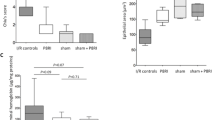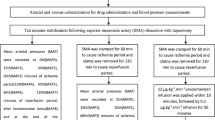Abstract
There is a large body of evidence that neutrophils may play an important role in the mucosal injury that follows ischemia of the intestine. Pentoxifylline (PTF), a methylxanthine derivative, prevents leukocyte adherence to vascular endothelium and restores intestinal blood flow following hemorrhagic shock and sepsis. The purpose of this study was to evaluate the protective properties of PTF in an ischemia-reperfusion model of the intestine and whether its action is mediated through tissue neutrophils as assessed by myeloperoxidase (MPO) determination. Intestinal ischemia of either 1 or 2 h was induced in rats by clamping the superior mesenteric artery, followed by a 17-min reperfusion period. PTF (25 mg/kg) or saline solution was injected IP 10 min prior to ischemia. Multiple bowel samples were harvested at the end of the reperfusion period and evaluated for histology and tissue MPO. PTF significantly changed the resultant histologic damage to the intestinal mucosa exerted by prolonged ischemia of 1 and 2 h duration, although the beneficial effect of PTF in this animal model was independent of the number of tissue neutrophils as assessed by tissue MPO levels. Pretreatment with PTF can thus reduce the histologic damage caused by prolonged ischemia to the intestine.
Similar content being viewed by others
References
Barroso AJ, Schmid SG (1990) Pentoxifylline pretreatment decreases the pool of circulating activated neutrophils, in-vivo adhesion to endothelium, and improves survival from hemorrhagic shock. Biorheology 27: 401–418
Berens KL, Langston JD, Wasan KM, Luke DR (1991) Influence of pentoxifylline and related analogues in endotoxemic renal failure. Circ Shock 34: 344–348
Bessler H, Gilgal R, Djaldetti M, Zahavi I (1986) Effect of pentoxifylline on the phagocytic activity, cAMP levels, and superoxide anion production by monocytes and polymorphonuclear cells. J Leukoc Biol 40: 747–754
Blume J, Ruhlmann KU, de la Haye R, Rettig K (1992) Treatment of chronic cerebrovascular disease in elderly patients with pentoxifylline. J Med 23: 417–432
Boogaerts MA, Malbrain S, Meeus P, van Hove L, Verhoef GE (1990) In vitro modulation of normal and diseased human neutrophil function by pentoxifylline. Blut 61: 60–65
Bowton DL, Stump DA, Prough DS, Toole JF, Lefkowitz DS, Coker L (1989) Pentoxifylline increases cerebral blood flow in patients with cerebrovascular disease. Stroke 20: 1662–1666
Caplan MS, MacKendrick W (1993) Necrotizing enterocolitis: a review of pathogenetic mechanisms and implications for prevention. Pediatr Pathol 13: 357–369
Ciuffetti G, Mercuri M, Ott C, Lombardini R, Paltriccia R, Lupattelli G, Santambrogio L, Mannarino E (1991) Use of pentoxifylline as an inhibitor of free radical generation in peripheral vascular disease. Results of a double-blind placebo-controlled study. Eur J Clin Pharmacol 41: 511–515
Ciuffetti G, Paltriccia R, Lombardini R, Lupattelli G, Pasqualini L, Mannarino E (1994) Treating peripheral arterial occlusive disease: pentoxifylline vs exercise. Int Angiol 13: 33–39
Dauber IM, Lesnefsky EJ, Ashmore RC, Martel DM, Sheridan FM, Weil JV, Horwitz LD (1992) Coronary vascular injury due to ischemia-reperfusion is reduced by pentoxifylline. J Pharmacol Exp Ther 260: 1250–1256
Dettelbach HR, Aviado DM (1985) Clinical pharmacology of pentoxifylline with special reference to its hemorrheologic effect for the treatment of intermittent claudication. J Clin Pharmacol 25: 8–26
Ernst E, Kollar L, Resch KL (1992) Does pentoxifylline prolong the walking distance in exercised claudicants? A placebo-controlled double-blind trial. Angiology 43: 121–125
Flynn WJ, Cryer HG, Garrison RN (1991) Pentoxifylline but not saralasin restores hepatic blood flow after resuscitation from hemorrhagic shock. J Surg Res 50: 616–621
Flynn WJ, Cryer HG, Garrison RN (1991) Pentoxifylline restores intestinal microvascular blood flow during resuscitated hemorrhagic shock. Surgery 110: 350–356
Granger DN, Kvietys PR, Perry MA (1993) Leukocyte-endothelial cell adhesion induced by ischemia and reperfusion. Can J Physiol Pharmacol 71: 67–75
Grisham MB, Benoit JN, Granger DN (1990) Assessment of leukocyte involvement during ischemia and reperfusion of intestine. Methods Enzymol 186: 729–742
Hadjiminas DJ, McMasters KM, Robertson SE, Cheadle WG (1994) Enhanced survival from cecal ligation and puncture with pentoxifylline is associated with altered neutrophil trafficking and reduced interleukin-1 beta expression but not inhibition of tumor necrosis factor synthesis. Surgery 116: 348–355
Hakim TS, Petrella J (1988) Attenuation of pulmonary and systematic vasoconstriction with pentoxifylline and aminophylline. Can J Physiol Pharmacol 66: 396–401
Hewett JA, Jean PA, Kunkel SL, Roth RA (1993) Relationship between tumor necrosis factor-alpha and neutrophils in endotoxin-induced liver injury. Am J Physiol 265: G1011-G1015
Ishizaka A, Hatherill JR, Harada H, Yonemaru M, Hoffman H, Zheng H, O'Hanley PT, Raffin TA (1989) Prevention of interleukin 2-induced acute lung injury in guinea pigs by pentoxifylline. J Appl Physiol 67: 2432–2437
Jewett A, Bonavida B (1994) Pentoxifylline suppresses interleukin-2-mediated activation of immature human natural killer cells by inhibiting endogenous tumor necrosis factor-alpha secretion. J Clin Immunol 14: 31–38
Korthuis RJ, Granger DN (1993) Reactive oxygen metabolites, neutrophils, and the pathogenesis of ischemic-tissue/reperfusion. Clin Cardiol 16: 119–126
Kremsner PG, Neifer S, Chaves MF, Rudolph R, Bienzle U (1992) Interferon-gamma induced lethality in the late phase of Plasmodium vinckei malaria despite effective parasite clearance by chloroquine. Eur J Immunol 22: 2873–2878
Langer JC, Sohal SS, Mumford DA (1993) Mucosal permeability in the immature rat intestine: effects of ischemia-reperfusion, cold stress, hypoxia, and drugs. J Pediatr Surg 28: 1380–1383
Mavrelis PG, Doumanian H (1987) Pentoxifylline for mesenteric ischemia. Am J Gastroenterol 82: 175
Megison SM, Horton JW, Chao H, Walker PB (1990) A new model for intestinal ischemia in the rat. J Surg Res 49: 168–173
Michal M, Giessinger N, Schroer R (1989) Reduced thrombus formation in vivo after administration of pentoxifylline (Trental). Thromb Res 56: 359–368
Mitsudo S, Brandt LJ (1992) Pathology of intestinal ischemia. Surg Clin North Am 72: 43–63
Mollitt DL, Poulos ND (1991) The role of pentoxifylline in endotoxin-induced alterations of red cell deformability and whole blood viscosity in the neonate. J Pediatr Surg 26: 572–574
Musemeche CA, Pizzini RP, Andrassy RJ (1993) Intestinal ischemia in the newborn: the role of intestinal maturation. J Surg Res 55: 595–598
Prada J, Prager C, Neifer S, Bienzle U, Kremsner PG (1993) Production of interleukin-6 by human and murine mononuclear leukocytes stimulated with Plasmodium antigens and tumor necrosis factor secretion is reduced. Infect Immun 61: 2737–2740
Raj JU, Kaapa P, Anderson J (1992) Age-related differences in vascular effects of pentoxifylline in isolated perfused ferret lungs. Dev Pharmacol Ther 18: 1–8
Refsum SE, Norwood W, Rowlands BJ, Boston VE (1993) Pentoxifylline improves resting membrane potential in sepsis. J Pediatr Surg 28: 1144–1146
Reignier J, Mazmanian M, Detruit H, Chapelier A, Weiss M, Libert JM, Herve P (1994) Reduction of ischemia-reperfusion injury by pentoxifylline in the isolated rat lung. Paris-Sud University Lung Transplantation Group. Am J Respir Crit Care Med 150: 342–347
Schade UF (1990) Pentoxifylline increases survival in murine endotoxin shock and decreases formation of tumor necrosis factor. Circ Shock 31: 171–181
Schroer RH (1985) Antithrombotic potential of pentoxifylline. A hemorrheologically active drug. Angiology 36: 387–398
Sigurdsson GH, Youssef H (1993) Effects of pentoxifylline on hemodynamics, gas exchange and multiple organ platelet sequestration in experimental endotoxic shock. Acta Anaesthesiol Scand 37: 396–403
Suzuki K, Ota H, Sasagawa S, Sakatani T, Fujikura T (1983) Assay method for myeloperoxidase in human polymorphonuclear leukocytes. Anal Biochem 132: 345–352
Tighe D, Moss R, Hynd J, Boghossian S, Saady N, Heath MF, Bennett ED (1990) Pretreatment with pentoxifylline improves the hemodynamic and histologic changes and decreases neutrophil adhesiveness in a pig fecal peritonitis model. Crit Care Med 18: 184–189
Toung TJ, Kirsch JR, Maruki Y, Traystman RJ (1994) Effects of pentoxifylline on cerebral blood flow, metabolism, and evoked response after total cerebral ischemia in dogs. Crit Care Med 22: 273–281
Udassin R, Ariel I, Haskel Y, Kitrossky N, Chevion M (1991) Salicylate as an in vivo free radical trap: studies on ischemic insult to the rat intestine. Free Radic Biol Med 10: 1–6
Udassin R, Vromen A, Haskel Y (1994) The time sequence of injury and recovery following transient reversible intestinal ischemia. J Surg Res 56: 221–225
van Leenen D, van der Poll T, Levi M, ten Cate H, van Deventer S, Hack CE, Aarden LA, ten Cate J (1993) Pentoxifylline attenuates neutrophil activation in experimental endotoxemia in chimpanzees. J Immunol 151: 2318–2325
Wang P, Ba ZF, Zhou M, Tait SM, Chaundry IH (1993) Pentoxifylline restores cardiac output and tissue perfusion after traumahemorrhage and decreases susceptibility to sepsis. Surgery 114: 352–358
Waxman K, Eloi L, Dinh L, Scannell G, Tominaga GT (1993) Pentoxifylline alone versus pentoxifylline combined with superoxide dismutase prolongs survival in a rat hemorrhagic shock model. Resuscitation 26: 237–242
Yonemaru M, Hatherill JR, Hoffman H, Zheng H, Ishii K, Raffin TA (1991) Pentoxifylline does not attenuate acute lung injury in the absence of granulocytes. J Appl Physiol 71: 342–351
Zabel P, Schade FU, Schlaak M (1993) Inhibition of endogenous TNF formation by pentoxifylline. Immunobiology 187: 447–463
Zheng H, Crowley JJ, Chan JC, Raffin TA (1991) Attenuation of LPS-induced neutrophil thromboxane b2 release and chemiluminescence. J Cell Physiol 146: 264–269
Zimmerman BJ, Granger DN (1992) Reperfusion injury. Surg Clin North Am 72: 65–83
Author information
Authors and Affiliations
Rights and permissions
About this article
Cite this article
Udassin, R., Vromen, A., Seror, D. et al. Pentoxifylline attenuates ischemia/reperfusion injury to the small intestine in the rat. Pediatr Surg Int 11, 329–333 (1996). https://doi.org/10.1007/BF00497805
Accepted:
Published:
Issue Date:
DOI: https://doi.org/10.1007/BF00497805




